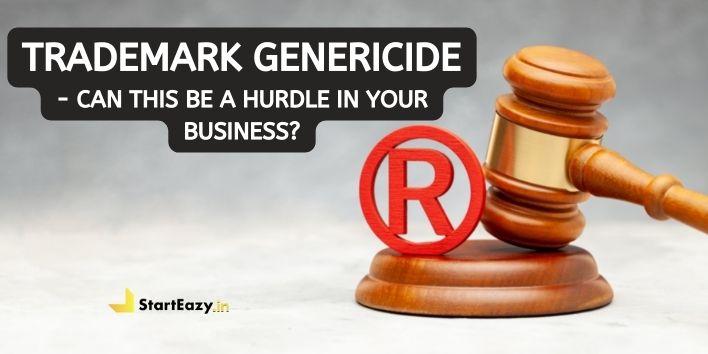The Trademarks Act of 1999 allows for trademark registration online, which are markings capable of being expressed graphically and differentiating one person's goods and services from those of another. Sections 9 and 11 of the Act make it abundantly plain that a mark must be sufficiently distinctive to be registered.
However, registered trademarks can succumb to general usage and enter the public domain. As a result, the trademark owner loses all rights to the trademark.
What is Trademark Genericide?
Genericide is a brand's worst nightmare: losing the trademark for a crucial product because it has become too profitable.
A trademark is any term, name, symbol, device, or any combination thereof, that differentiates a product or service from other products or services in the marketplace and is recognised as a source indicator by customers.
Trademarks serve several important functions, including identifying and distinguishing the trademark holder's products or services from those of competitors. As well as informing consumers that products or services bearing said marks come from a specific source and are of comparable quality.
The Reasons for Trademark Genericide
The reason for Trademark Genericide is straightforward. The trademark becomes genericized as a result of the public's continued usage of the term to designate a specific product rather than its source. The more popular the product, the odds of it dying a generic death increase. Aspirin, Cellophane, Zipper, Kleenex, Thermos, Popsicle, and more popular trademarked names have since become generic due to improper and ongoing public use.
The word 'escalator' is catchy and whimsical, and it is much easier to say than the word moving staircase,' which is used by the Otis Elevator Company. Another cause of trademark genericide is corporations' contradictory behaviour toward their trademark. Companies want their products to become well-known, but they don't want the general public to use the trademark to identify the product rather than the source of the product. Ineffective promotion and insufficient control procedures are the reasons why trademarks such as Kleenex, Trampoline, and others have become generic phrases.
To keep a brand from getting genericized, its owners must be highly watchful and take proactive actions to safeguard its trademark.
- Using the product's generic name as well as the trademark. 'Q-Tip' for cotton swabs, for example.
- The trademark is used as an adjective rather than a noun or verb. For example, rather than stating "Google it," refer to the trademark "Google" as "Run a search on Google."
- Giving proper notification to consumers of a registered trademark by utilising either the letter R wrapped within a circle – ® or 'TM' for an unregistered mark.
- Raising objections to trademark infringement through issuing cease and desist letters, beginning legal action for passing off or infringement, and so on.
- Misuse is frequently caused by a lack of education rather than malicious intent.
- In such a circumstance, proprietors might take suitable steps to educate the public about correct mark usage. In 2017, the owners of the trademark "Velcro" created a YouTube video titled "Don't Say Velcro" in which they voiced their worry about the use of their registered brand as a noun or a verb and taught consumers about its proper usage.
Procedures for Avoiding Trademark Genericide
- Trademark owners should avoid using their mark as a verb or noun, as this implies that the word is generic.
- In addition to the fancy trademark name, trademark owners should provide a new product with an easily known generic name.
- Trademark owners must be particularly careful to prevent improper usage of their brand.
- On product packaging, trademark owners may include the word "brand" after their trademark.
- Trademark owners must develop guidelines for the usage of their trademarks and make sure that they are followed strictly. Companies should create a rigorous trademark regimen to protect their trademark from becoming generic.
In general, a trademark's job is to identify goods and services in the marketplace from those of other companies, not to describe the goods or services. Because a trademark can help you grow your brand identification and build client loyalty, consistency is essential. You want to showcase your brand consistently across all media—print and electronic.
In addition, after trademark registration online, the owners should use the proper mark (® if registered, TM if unregistered) to designate their distinctive words or phrases.
According to Heymann, genericide is "more likely to occur if competitors in the field begin using the trademark as the common name for their own products." As a result, the second most important thing a trademark owner can do is watch for competitors who are stealing their mark and utilising it generically.
Trademark owners should also be on the alert for media outlets and anyone misusing their marks. However, as Heymann suggests, a gentle approach to resolving the issue may be preferable to "shooting out aggressive cease-and-desist letters."
Your most valuable asset is your brand. It not only determines who you are as a company today, but it can also influence who you will be tomorrow.
Conclusion
Brands must be aware of the ways in which their trademark can be harmed. This can include attempting to anticipate concerns that will not arise until far later in the process, such as trademark genericism. Brands can suffer if trademarks are not protected. Duncan Toys, for example, lost a case in 1965 to preserve its Yo-Yo brand, resulting in the company declaring bankruptcy.
However, as we've shown, there are techniques available to avoid this. Brands are asked to ensure that protected names are clearly labelled as trademarks, that their product name is not used as a normal noun, and that the trademark is treated appropriately in the media.
